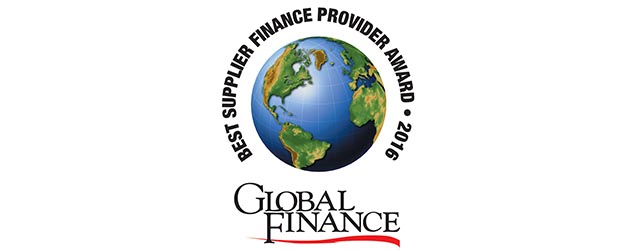
Back to Awards Coverage
GLOBAL WINNERS
Best Supply Chain Finance Provider—Bank | BNP Paribas
For a significant number of banks, supply chain finance offerings are geared primarily toward large credit-worthy buyers and the suppliers they have identified as wanting to assist with supply chain finance programs. But BNP Paribas’s Global Trade Solutions business, including supplier finance, focuses on the needs of a wide range of buyers, suppliers and distributor financing programs. One of the bank’s unique selling points is its inventory management business, Utexam, based in Dublin. Operated as a subsidiary of the bank, it can purchase inventory on behalf of a supplier and sell it back to them, providing liquidity much earlier in the supply chain—pre-shipment—than other supplier finance solutions, which tend to be post-shipment, based on buyer-approved invoices.
Best Supply Chain Finance Provider—Nonbank | Orbian
A stalwart in the supplier finance space, Orbian has faced increased competition from web-based providers like PrimeRevenue and other nonbank start-ups. But its well-differentiated funding model, which aims to attract not just banks but other classes of investor (hedge funds, private equity) interested in trade receivables as an asset class, and its emphasis on straightforward supplier enrollment and enablement—the key to success of any SCF program—have contributed to its longevity in the business. Its funding model means suppliers do not need to deal directly with banks, which suits those companies seeking more-flexible financing options for their SCF program outside of their house bank. Although Orbian has not embraced Cloud or Web-based technologies to the same degree as some of the start-ups, companies that have worked with Orbian praise its funding model, supplier enrollment and support. In 2015, Orbian handled supplier-funding transactions worth approximately $18 billion and total transaction volumes in excess of $21 billion.
Best Customer Implementation of a Supply Chain Finance Solution | PrimeRevenue/Michelin
More and more companies see supply chain finance as a way not just of helping their suppliers but also of enhancing their own financial position. As part of a long-term business plan, French-based tire manufacturer Michelin aims to deliver €1 billion euros ($1.1 billion) in structural cash flow per year and a 15% return on capital from 2020 by using SCF to extend payment terms for its trade payables with suppliers. Michelin chose PrimeRevenue because it is an independent banking platform with access to 50 funders and can provide support across multiple currencies and countries. As part of its SCF program, Michelin was able to extend payment terms by 30 days in return for suppliers’ being paid earlier by funders in the program. Its SCF program was initially rolled out in North America, Europe and China and then ramped up to include other countries and regions. Michelin said its SCF program has resulted in a €65 million cash flow improvement.
Best Platform Connecting Buyers, Suppliers and Financial Institutions | GT Nexus
As one of the largest Cloud-based e-commerce platforms, GT Nexus gives 18,000-plus suppliers and 750 buyers tools for doing business in a more cost-efficient manner and leverage the power of data. Brand names such as Levi Strauss, Columbia Sportswear, DHL and Pfizer use GT Nexus’s Cloud-based platform to collaborate with key suppliers. More than 20 financing providers are able to leverage the transactional data captured by the collaborative e-commerce network to extend financing at different stages in the supply chain to the companies most in need of it. GT Nexus recently launched a preshipment financing option for small and standard sellers on its platform. The solution enables bespoke supply chain finance provider Seabury TFX to leverage the transactional history of suppliers on GT Nexus to provide purchase order financing at different stages in the preshipment process.
Best E-Procurement | SAP Ariba
SAP Ariba has a large and well-established e-procurement network, used by approximately two million companies in more than 190 countries. Since being acquired by enterprise software provider SAP, based in Germany, the Cloud-based network’s tighter integration with companies’ ERP systems—backed up by more-powerful digital business flow capabilities and analytics from SAP’s next-generation enterprise business software suite SAP S/4HANA—should, in theory, further simplify the order-to-purchase process.
Best Analytics for Credit Scoring and Supplier Risk Assessment | Dun & Bradstreet
The New Jersey—headquartered company provides an array of information—credit scoring, country risk assessments, supplier risk assessments and business economics information—that can help companies better manage, understand and prepare for risks that could negatively impact their network of strategic suppliers. Dun & Bradstreet data can be used to determine whether suppliers are compliant with international regulations. It also provides an online alert service, notifying companies of unexpected events that could disrupt their supply chains.
Best Invoice Discount Management | SAP Ariba
SAP Ariba is best known for its e-procurement platform, but with a foothold in the e-invoicing space, it realized early on that digitizing invoices was not just about getting rid of costly and inefficient paper-based processes but also enabling companies to benefit from discounts for paying invoices earlier. Early-payment discount management can be automated by using SAP Ariba’s dynamic discount management platform, which is integrated with companies’ ERP systems. Invoices can be discounted on an ad-hoc or automatic basis, or on a sliding scale. Discount offers can also be made to different groups of suppliers.
Best-Integrated Trade, Supply Chain Finance and Cash Management Solutions | Citi
Having organized its cash management and trade businesses under the moniker of Treasury and Trade Solutions, Citi promotes a streamlining of the two business lines to enhance companies’ working capital. The bank says it is less focused on product and more on a “consultative trouble-shooting” approach to understand companies’ supply chain needs. Citi’s SCF team leverages its CitiConnect ERP Integrator, which integrates its online banking platform with companies’ ERP systems to help incorporate FX into supplier finance payments. It has also more closely integrated its cross-border payments solution, WorldLink, with its SCF offering.
Best Web-Based Supply Chain Financing Solution | Basware
The Finnish firm has long been a strong provider in the purchase-to-pay space, leveraging its Commerce Network, an open business network connecting more than one million companies in 100 countries, and Cloud-based solutions to help companies automate their accounts payable processes. Recently, it has added Basware Advance, an online, invoicing-based financing solution for SMEs; Basware Pay, an electronic payment solution for suppliers; and Basware Discount, a buyer-funded supplier discounting solution.
REGIONAL WINNERS
North America | J.P. Morgan
A leading trade finance provider, J.P. Morgan also boasts a mature set of supply chain finance capabilities, with programs spanning multiple countries and suppliers. J.P. Morgan supports financing options that include the ability to source liquidity from outside investors that see trade receivables as an attractive asset class. It also works with export credit agencies like the US Ex-Im Bank, which has played an increasingly important role in SCF by providing guarantees that enable banks to extend early payment to smaller companies that would not normally be able to attract favorable or affordable financing.
Western Europe | BNP Paribas
The French bank’s Global Trade Solutions business boasts supply chain financing solutions spanning payables, receivables and distributor financing. BNP Paribas’s Connexis electronic supply chain finance platform has more than 5,000 counterparties registered and handles in excess of 700,000 transactions a year. Suppliers can use the platform to select what invoices to discount and when. The supplier financing programs span multiple countries and regions, including France, the Nordics, Germany, Italy, the US, the Middle East and Asia.
Nordic Region | Danske Bank
The Nordic bank’s SCF program origination peaked in 2015 with the awarding of 16 Nordic mandates, 12 of which spanned multiple countries and currencies. SCF is the fastest-growing area of Danske Bank’s transaction banking business. It uses technology innovatively to simplify supplier onboarding and minimize the technical changes suppliers need to make to participate in SCF programs. Its online SCF module let suppliers cherry-pick which invoices can be discounted in return for early payment, and it places no restrictions on how late suppliers can sell an invoice before maturity date. It also provides a benchmarking service so companies can see how they stack up against their peers in key working-capital metrics.
Central & Eastern Europe | UniCredit
UniCredit describes itself as a “multilocal international bank with a deep reach throughout CEE,” with a direct presence in 14 markets and an extensive branch network. The bank supports SCF programs spanning multiple countries across the region, including markets like Turkey and Russia, where clients demand sophisticated, innovative solutions. While some banks support SCF programs only for large, credit-worthy buyers, UniCredit supports both supplier- and buyer-driven programs.
Latin America | Santander
The largest financial group in Latin America, Santander was one of the early innovators there in reverse-factoring, or confirming (a buyer selling payables or confirmed invoices in order to extend financing to suppliers and attract an early payment discount). The Spanish bank’s main markets in the region are Brazil, Mexico, Chile and Argentina. It’s extensive network and knowledge of the region and its relationship with SMEs makes it well placed to serve the increasingly complex working-capital needs of Latin American companies, which may find it difficult to source affordable financing via more-traditional means such as bank credit lines. International Finance Corporation estimates a $235 million financing gap for SMEs in Latin America.
Caribbean | Citi
Citi has supply chain finance capabilities in more than 70 countries worldwide and can facilitate transactions in 110 countries, says John Ahearn, global head of trade, Citi Treasury and Trade Solutions. Citi also says it uses standardized processes, so buyers and suppliers can benefit from a fully automated, end-to-end solution. This approach has helped it gain market share in several Caribbean countries. Companies in the region that trade globally can benefit from Citi’s extensive global franchise and knowledge of structuring supply chain finance programs in other regions of the world.
Asia-Pacific | DBS Bank
Trade and supply chain finance is one of the fastest-growing aspects of DBS’s transaction banking business. For a bank that seriously started investing in transaction banking only in 2009, its supply chain finance offering has come a long way in a short span of time. The bank embraces everything digital, working on mobile applications in the supply chain finance space and exploring the use of distributed ledger technologies, otherwise known as blockchain, to help bring the paper-laden world of trade into the digital age. The bank tailors solutions to customers needs, whether around invoice discount management or SCF programs across Asia.
Middle East | Citi
Supply chain finance has yet to take off in the Middle East. Most trade is still conducted using traditional trade finance instruments or on open account. Increasingly, however, corporates in the region are starting to see supply chain financing as a means of enhancing working capital efficiency and their balance sheet. Accessing liquidity may not be an issue for most companies in the region, but using SCF to extend payment terms with their key suppliers can deliver greater working capital efficiencies for buyers and suppliers.
Africa | Standard Chartered
Standard Chartered offers a full suite of supply-chain-finance solutions aimed at both buyers and suppliers in 15 African markets. In total, the bank covers 37 markets in sub-Saharan Africa, including countries where it operates via an alliance bank network. Its proprietary credit model, which focuses on the trading history and strength of relationships between buyers and suppliers rather than just the supplier’s balance sheet, is well suited to emerging markets, where suppliers tend to be small companies that typically find it difficult to access traditional bank financing.



